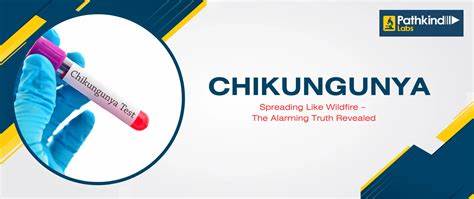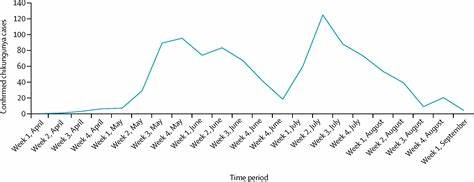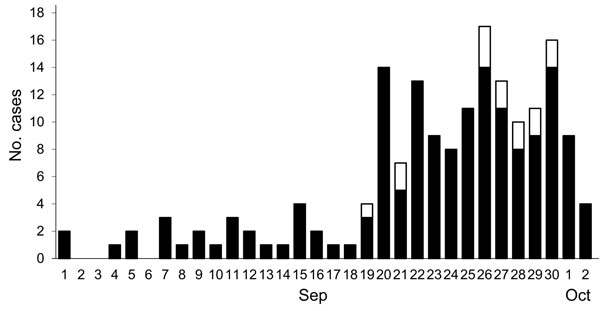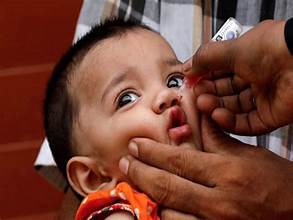As of early August 2025, China’s Guangdong province has confirmed over 7,000 cases of chikungunya fever since the outbreak began in July. The situation has triggered a level of response reminiscent of COVID‑19 containment strategies, illustrating how unpredictable and serious vector‑borne threats can become—even in regions where they were once nearly unheard of.
Rising Numbers and Scope of the Outbreak
The outbreak appears to have started in Foshan, particularly the Shunde district, where nearly 90 percent of cases have been recorded. Between July 27 and August 2 alone, 2,892 new infections were reported, pushing the total to over 7,700 by early August 5 — highlighting a steep acceleration aided by heavy rainfall and widespread mosquito populations
The virus has now spread beyond Foshan, with at least 12 other cities in Guangdong province reporting cases. Hong Kong has confirmed its first imported case in six years, a 12‑year‑old who visited Foshan in July
Symptoms, Severity, and Risk Profile
Chikungunya virus (CHIKV) is transmitted by Aedes mosquitoes (especially Aedes aegypti and Aedes albopictus), which are active during daylight hours. The incubation period ranges from 2 to 12 days, average 3–7 days. Common acute symptoms include high fever, intense joint pain, rash, headache, muscle aches, and fatigue. While most patients improve within a week, joint pain can persist for months or even years in some cases
Thankfully, all reported cases in Guangdong so far have been classified as mild, with approximately 95 percent of patients discharged within seven days, and no fatalities reported to date Still, the long-term impact on vulnerable groups—infants, the elderly, and those with pre‑existing conditions—remains a concern
Government Response: COVID‑Style Measures

Guangdong authorities have rapidly mobilized to contain spread, enacting measures reminiscent of China’s COVID response. In Foshan, all chikungunya patients are hospitalized under mosquito nets and can only be discharged after a negative test or completion of seven days’ admission
Authorities have also imposed real‑name registration for purchases of medications used to treat related symptoms. Pharmacies are required to keep detailed records of buyers and travel or exposure histories
Broader control measures include area-wide mosquito eradication campaigns, mobilizing community clean‑ups, drone surveillance to detect stagnant water, and distributing fines of up to 10,000 yuan (~$1,400) for households or businesses that fail to eliminate mosquito breeding sites such as water‑filled containers or flowerpots (.
Innovative Vector Control Techniques
In addition to traditional chemical control and habitat reduction, Guangdong has deployed biological control methods, such as releasing larvae‑eating fish into ponds and water bodies, and introducing Toxorhynchites splendens (“elephant mosquitoes”) whose larvae consume Aedes larvae but do not bite humans
International Response and Travel Notices
In response to the growing outbreak, the U.S. Centers for Disease Control and Prevention (CDC) is considering issuing a travel notice for China. As of July 26, Guangdong had already reported around 4,824 confirmed cases, prompting heightened scrutiny of travel and health risk
Hong Kong health authorities have issued guidance on mosquito bite prevention, travel advisories, and special warnings for pregnant women, since vertical transmission to newborns can cause severe illness

Why This Outbreak Matters
Chikungunya is typically rare in China, with sporadic imported cases in previous years (e.g. 2010, 2019). This outbreak represents one of the largest recorded events in Chinese history, showing how changing climate patterns, increased mobility, and global virus circulation can spark unexpected health challenges indoors
The convergence of monsoon rains, rising temperatures, and urban density in Guangdong created ideal conditions for Aedes mosquitoes to flourish. In turn, a probable imported index case triggered sustained local transmission via these vectors
Public Health Recommendations
Authorities stress proactive prevention:
- Eliminate stagnant water in homes and public spaces.
- Use mosquito repellents, nets, window screens, and wear protective clothing.
- Seek medical testing promptly if symptoms like fever, rash, or joint pain appear, especially within two weeks of travel to affected areas.
- Inform pharmacies or healthcare providers of travel history or mosquito exposure when purchasing symptom remedies.
Although there are vaccines approved in the U.S. and EU (e.g. Ixchiq, Vimkunya), use has been limited and regulators have paused use in older age groups due to rare neurological or cardiac side effects. Vaccines are not yet publicly available in China
Looking Ahead
Health officials in China and globally are closely monitoring whether the outbreak peaks or spreads beyond Guangdong. So far, the curve may be flattening, with newly reported cases declining in Shunde District after targeted interventions, though risk remains high as extreme weather and imported strains persist ).
Ongoing surveillance, vector control, public education, and cross‑border coordination remain essential to prevent further spread. For travelers, staying informed and cautious around mosquito-prone areas is equally important.



